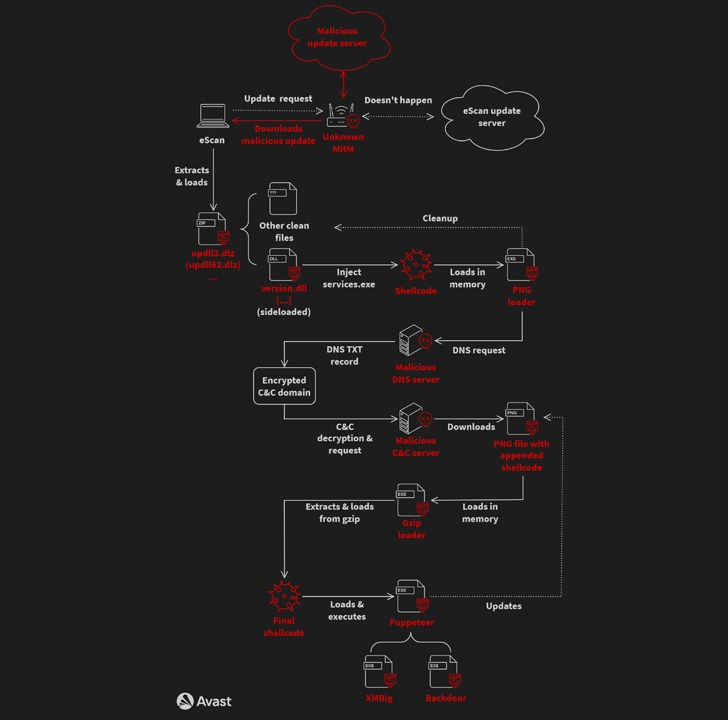
A brand new malware marketing campaign has been exploiting the updating mechanism of the eScan antivirus software program to distribute backdoors and cryptocurrency miners like XMRig by a long-standing menace codenamed GuptiMiner concentrating on massive company networks.
Cybersecurity agency Avast mentioned the exercise is the work of a menace actor with potential connections to a North Korean hacking group dubbed Kimsuky, which is also called Black Banshee, Emerald Sleet, and TA427.
“GuptiMiner is a extremely refined menace that makes use of an attention-grabbing an infection chain together with a few methods that embrace performing DNS requests to the attacker’s DNS servers, performing sideloading, extracting payloads from innocent-looking photos, signing its payloads with a customized trusted root anchor certification authority, amongst others,” Avast mentioned.
The intricate and elaborate an infection chain, at its core, leverages a safety shortcoming within the replace mechanism of Indian antivirus vendor eScan to propagate the malware by the use of an adversary-in-the-middle (AitM) assault.

Particularly, it entails hijacking the updates by substituting the package deal file with a malicious model by benefiting from the truth that the downloads weren’t signed and secured utilizing HTTPS. The problem, which went unnoticed for no less than 5 years, has been rectified as of July 31, 2023.
The rogue DLL (“updll62.dlz”) executed by the eScan software program side-loads a DLL (“model.dll”) to activate a multi-stage sequence beginning with a PNG file loader that, in flip, employs malicious DNS servers to contact a command-and-control (C2) server and fetch a PNG file with appended shellcode.
“GuptiMiner hosts their very own DNS servers for serving true vacation spot area addresses of C&C servers through DNS TXT responses,” researchers Jan Rubín and Milánek mentioned.
“Because the malware connects to the malicious DNS servers immediately, the DNS protocol is totally separated from the DNS community. Thus, no official DNS server will ever see the site visitors from this malware.”
The PNG file is then parsed to extract the shellcode, which is then answerable for executing a Gzip loader that is designed to decompress one other shellcode utilizing Gzip and execute it in a separate thread.
The third-stage malware, dubbed Puppeteer, pulls all of the strings, finally deploying the XMRig cryptocurrency miner and backdoors on the contaminated programs.

Avast mentioned it encountered two various kinds of backdoors that come fitted with options to allow lateral motion, settle for instructions from the menace actor, and ship further elements as required.
“The primary is an enhanced construct of PuTTY Hyperlink, offering SMB scanning of the native community and enabling lateral motion over the community to doubtlessly susceptible Home windows 7 and Home windows Server 2008 programs on the community,” the researchers defined.
“The second backdoor is multi-modular, accepting instructions from the attacker to put in extra modules in addition to specializing in scanning for saved personal keys and crypto wallets on the native system.”
The deployment of XMRig has been described as “sudden” for what’s in any other case a posh and meticulously executed operation, elevating the likelihood that the miner acts as a distraction to forestall victims from discovering the true extent of the compromise.
GuptiMiner, recognized to be energetic since no less than 2018, additionally makes use of varied methods like anti-VM and anti-debug methods, code virtualization, dropping the PNG loader throughout system shutdown occasions, storing payloads in Home windows Registry, and including a root certificates to Home windows’ certificates retailer to make the PNG loader DLLs seem reliable.

The hyperlinks to Kimusky come from an data stealer that, whereas not distributed by GuptiMiner or through the an infection movement, has been used “throughout the entire GuptiMiner marketing campaign” and shares overlaps with a keylogger beforehand recognized as utilized by the group.
It is presently not clear who the targets of the marketing campaign are, however GuptiMiner artifacts have been uploaded to VirusTotal from India and Germany as early as April 2018, with Avast telemetry knowledge highlighting new infections doubtless originating from out-of-date eScan purchasers.
The findings come because the Korean Nationwide Police Company (KNPA) referred to as out North Korean hacking crews akin to Lazarus, Andariel, and Kimsuky for concentrating on the protection sector within the nation and exfiltrating precious knowledge from a few of them.
A report from the Korea Financial Every day mentioned the menace actors penetrated the networks of 83 South Korean protection contractors and stole confidential data from about 10 of them from October 2022 to July 2023.
